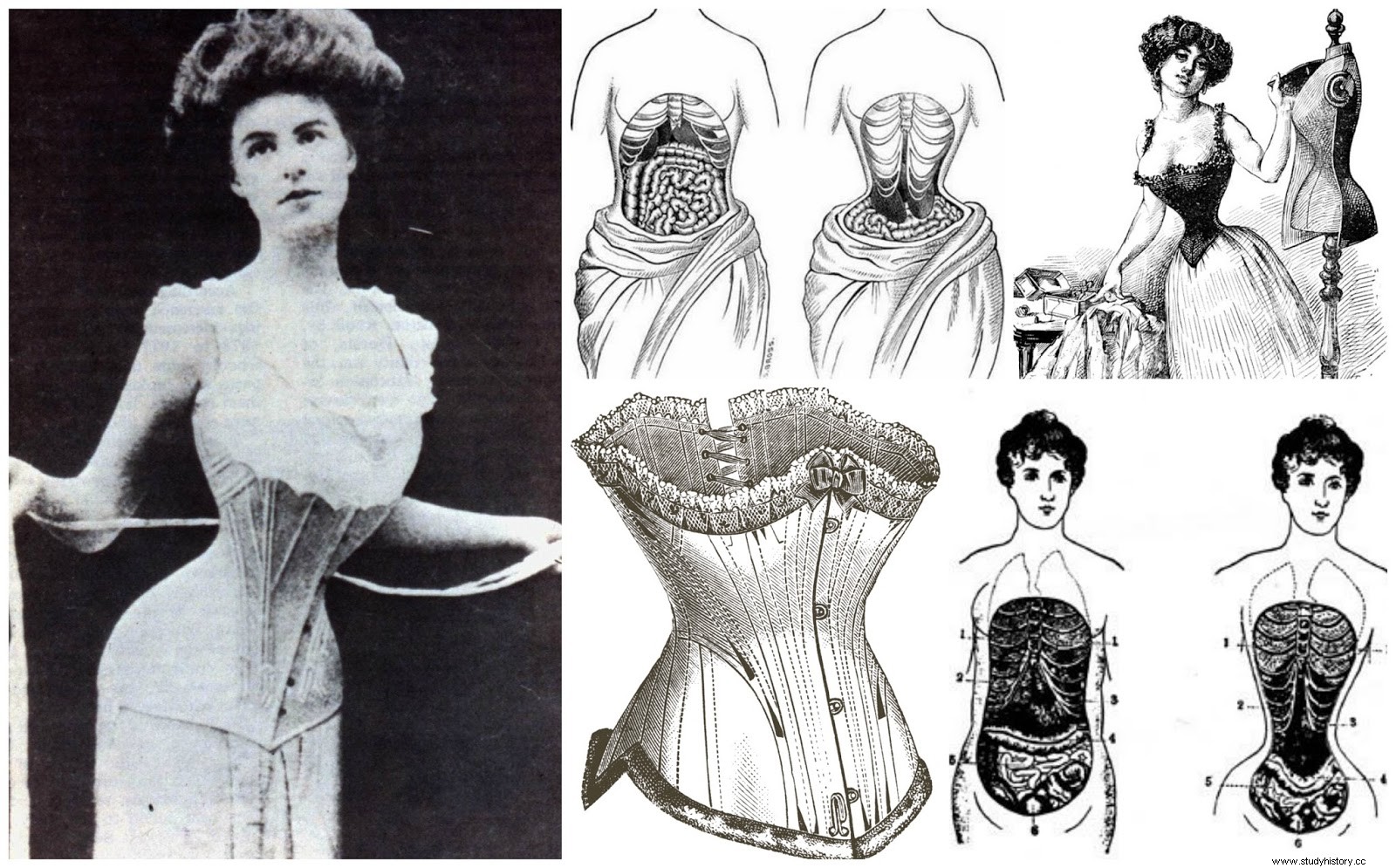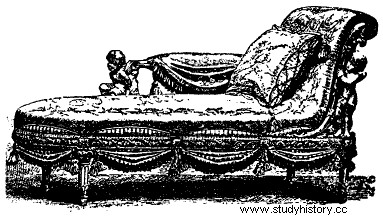The ideals of beauty have evolved throughout history and, logically, fashion has had to adapt to these canons. While men's clothing was becoming simpler until it became a three-piece suit (trousers, jacket with vest and shirt), women's clothing became more and more complicated, until it became dangerous in the mid-nineteenth century when it was adapted to the ideal of extreme beauty of the time:enhanced bust, an impossible waist refined by the corset and huge hips artificially manufactured with frames under the fabric to increase the size of the skirts. Although these frames had been used among the European nobility since the end of the 15th century -baby guards, because they allowed to hide pregnancies, tontillos or hollowers-, none of them reached the limits of the absurd hoop skirt or crinoline.

In the early days it was easy to get those flared skirts by stuffing them with starched petticoats. Two or three to begin with, and in this way they were manageable and bearable, but as women seemed to compete for the widest skirt, petticoats were added… up to 14. To save weight and alleviate the suffocating heat of so many garments, petticoats were made. attempts to make skirts larger without adding petticoats. For example, putting bicycle tires around that were inflated with air or water (this last option could be very embarrassing if a leak occurred). Until the mid-19th century in Paris, the crinoline appeared, a cage-type frame that replaced all petticoats made with horsehair and linen (crinis and linum, hence its name).

Going through the doors (the architecture of the new houses was modified to adapt them to crinolines), sitting on the chairs, getting into the carriages... everything in the day-to-day life was complicated with that contraption and, sometimes, deadly. The greatest danger of crinolines lay in the high risk of fire at a time when fire was very present in fireplaces, kitchens and lighting. It was very difficult to move with the crinolines having to be aware of such a large perimeter, so it was very easy for them to inadvertently approach a fire and set the skirt on fire. In fact, the New York Times published an advertisement in 1858 that warned of the danger of these garments, which caused an average of three deaths a week. The most terrible case occurred on December 8, 1863 when more than 2,000 people died in the church of the Society of Jesus in Santiago de Chile. A candle started a fire in the altar that spread quickly, but the tragedy came when panicked people tried to flee but I was impossible with the crinolines. But it was not all negative. Some women knew how to make “good” use of the huge hole left under their skirts. During the US Civil War, Southern women hid weapons and contraband, circumventing the Union's ban on bringing goods to the Confederate states.
In Spain he was responsible for the birth of a risky profession:the squeezer or drainer. The Spanish Golden Age, between the 16th and 17th centuries, marked one of the most brilliant and productive periods of Spanish culture in all its disciplines:literature, painting, music, architecture and theatre. In the theater authors such as Lope de Vega (the most prolific author of our literature), Calderón de la Barca or Tirso de Molina stood out and, in addition, the first permanent theaters were built for the representation in the patios of houses or inns:the corrals of comedy (although they represented comedies, tragedies and dramas). There was another circumstance that helped to popularize the theater:all social classes could access the performances -together but not mixed up-.

According to the structure of these theaters, each estate had its place:the stage was installed at one end of the patio, against the wall of the house in the background; In front of the stage was the open patio, at the end of which the men sat and in front of them the so-called musketeers (men who attended standing and who enjoyed the privilege of shouting, throwing objects and even bursting the performance if it was not to their liking ); the balconies and windows of the adjoining houses formed the rooms reserved for noble people, whether men or women, and the clergy; and the casserole, a box in front of the stage, where commoner women were located. In the cazuela is where our tightener or hollower worked. He was a kind of usher for the women, and although his work was already very difficult, because it was a small and limited space, it became impossible when the women wore panniers or cuppers.
In his sonnet Pointed Woman in Petticoat , the great Quevedo remembered these gadgets:
If you're a bell, where's the clapper?;
if you're a walking pyramid, go to Egypt;
if it's a backwards spinning top, bring a superscription;
if you're a sugar loaf, I'll fit you in Motril.
And no less dangerous was the corset, from the French corset (bodice, diminutive of corps, body). In the 17th century and much of the 18th century, all women of the aristocracy and nobility displayed this garment that helped model the perfect body of the time and, in addition, determined their social status. Logically, the more radical that diabolo figure was, the better. Leaving aside the corsets of the 16th century, authentic metal cages, in later centuries rigidity was achieved by inserting whalebones, metal or wood rods into the piece of cloth.

As a symbol of everything that the Old Regime represented, with the French Revolution the corset fell into disuse, but not into oblivion. In the 19th century, women returned to the corset and, on this occasion, from very early ages and from any social stratum. And although the normal thing is that it was not a garment for permanent use, its daily use and the continuous subjection of the body to excessive constriction resulted in bodily deformations to the point of affecting the disposition of the organs. In 1790 the German doctor Samuel von Sommering already warned that "the corset caused serious deformation of the ribs". And not only that, the young women came to force their body so much, for the sake of a narrower waist, that it was common for them to lose consciousness due to breathing difficulties. In fact, at the beginning of the 19th century, the British surgeon William Wilberfoce-Smith and the American gynecologist Robert Latou Dickinson conducted a study with more than 1,000 women and showed that more than 20% of those who wore corsets had reduced lung capacity. Precisely, this consequence of the use of the corset was a key circumstance for the appearance of a new piece of furniture in the residences of the French nobility of the 18th century:the chaise longue (long chair). Being frequent and habitual the fainting among the females, a kind of prie-dieu was needed to rest and, in addition, in which they "fit" with the exaggerated volume of their skirts. The townspeople called it “the fainting chair.”

Recent studies by the Mayo Clinic (USA) confirm the problems that prolonged use of this garment can cause:displacement of organs, respiratory stress, venous congestion, muscle deformation and interference with digestive processes.
On other occasions, women's clothing is not influenced by fashion, but by current legislation. After the victory in the Spanish Civil War, the totalitarian regime imposed by Francoism developed an exhaustive control of all facets of daily life, as well as the media, with the aim of indoctrinating and controlling the population. Submission, service and sacrifice were the values transmitted to a woman who should be a wife, mother and servant of the country. In clear inferiority with respect to men, the woman's life was limited to caring for the home and children, and her public life was limited to communing and collaborating with the interests of the Regime. In close collaboration with the Church, rules of conduct and dress codes were even drawn up. We find proof of this in Iberia:Spanish Travels and Reflections (1968), the work of the American writer James Albert Michener, winner of the Pulitzer Prize in 1948.
Spain is an immemorial land like no other. […] story of bullfighters and warrior kings, painters and processions, cathedrals and olive groves, where the sympathy of living souls pushes against the dark weight of history. Wild, contradictory, passionately beautiful, this is Spain.
On this tour of Spain –”the castle of old dreams and new realities” -, Michener includes some rules of conduct for women found in a small town -of which he does not mention the name-, dated 1943 and nailed to the door of the town's Church, by way of Luther's theses in the Church of the Wittenberg Palace.
1.- Women will not go out into the streets of this town with dresses that are too tight in those places that provoke the low passions of men.
2.- They should never wear dresses that are too short.
3.- They must be especially careful not to wear dresses that have a cut in the front.
4.- It is embarrassing for women to go down the street with short sleeves.
5.- Women on the street should wear stockings .
6.- Women may not wear transparent or fishnet clothing over those parts that decency requires to be covered.
7.- At the age of twelve, girls must start wearing stockings and dresses that reach the knee.
8.- Girls should never walk in remote places because doing so is immoral and dangerous.
9.- It is not decent for women and girls to ride bicycles.
10.- It is not decent for women to wear pants.
11.- Modern dance in cities is strictly prohibited.
